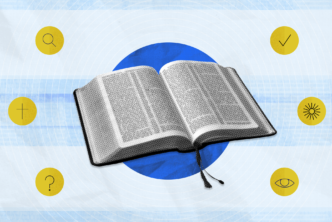I drove past the Christmas light display in the center of town and my preschooler gazed at the glistening colors and yelled, “Jesus is the light of the world!” She no doubt learned this in Sunday school, but is Jesus a string of red and green lights? Uh, no. So, how is Jesus the light of the world?
The Gospel of John provides special insight.
John’s imagery of light
John writes the first few verses of his Gospel like a creative paraphrase of Genesis 1. He describes Jesus as the Word, and he says that all things (including light) were made through him. John opens his Gospel this way:
In the beginning was the Word and the Word was with God and the Word was God. (John 1:1–2; see also Gen 1:1–3)
Next, John declares that Jesus had life in him—and “that life was the light of mankind. Light shines in the darkness, and the darkness has not overcome it” (John 1:4–5, emphasis mine; see also Gen 1:3–4).
So far, we see Jesus as life and light in contrast to darkness. There is a duality. Jesus is not darkness—he is the opposite of darkness. He is light.
Then, the apostle John describes the ministry of John the Baptist, the one who came before the Messiah. He writes,
He came as a witness to testify concerning that light, so that through him all might believe. He himself was not the light; he came only as a witness to the light. (John 1:6–8, emphasis mine; see also Isa 40:3)
The last mention of light in John 1 refers to Jesus arriving on the scene:
The true light that gives light to everyone was coming into the world. (John 1:9)
In John 1 we learn five things about light:
- Jesus is the light of mankind (1:4)
- The light is the source of life (1:4)
- The light shines in the darkness and is not the darkness (1:5)
- John is not the light, but John told others about the light (1:6–8)
- The true light gives light to everyone but is also not recognized (1:9–10)
Imagery of light in the rest of John
The Gospel of John continues a few chapters later with a Pharisee (religious ruler) named Nicodemus, who came to Jesus in the night (darkness). Nicodemus wanted Jesus to tell him who Jesus is.
Jesus told Nicodemus that he needed to be born again, but this only confused Nicodemus. Jesus then explained to him the need to come into the light.
This is the verdict: Light has come into the world, but people loved darkness instead of light because their deeds were evil. Everyone who does evil hates the light, and will not come into the light for fear that their deeds will be exposed. But whoever lives by the truth comes into the light, so that it may be seen plainly that what they have done has been done in the sight of God. (3:19–21, emphasis mine)
Here we learn about light from John 3:
- Light has come into the world
- People love the darkness
- The darkness is associated with evil
- Truth is the way into the light
Later in John 5, Jesus testifies about himself and refers back to the John the Baptist’s testimony. He describes John’s ministry as a lamp that burned and gave light (5:33–35), but even though John gave light, he was not the light.
Further in the Gospel of John, we come to the passage where Jesus calls himself the light. “I am the light of the world. Whoever follows me will never walk in darkness, but will have the light of life” (8:12; see also 11:9).1
In John 5, 8, and 11 we see:
- Jesus himself is the light
- “Darkness” refers to those who do not follow Jesus (the light)
- Those that follow Jesus (his disciples) will have the light that Jesus has, the “light of life”
Next, John 9 further defines Jesus as the light as he heals a man born blind, “While I am in the world, I am the light of the world” (John 9:5, emphasis mine). We can safely infer from this verse that when Jesus is not in the world (i.e., ascends into heaven), something/someone else is the light of the world.
In fact, John 12:36 says, “Believe in the light while you have the light, so that you may become children of light.” So, now we move from just Jesus as the light, to people becoming “children of light” by faith in the light (Jesus).
In the Gospel of John, Jesus is imaged as light (holy, good, true) and those who believe and follow Jesus are “children of light.” This stands in contrast to those who do not believe in the truth of Jesus; they walk in darkness and sin.
The image of light other places in Scripture
Light imagery is not found only in John, of course.
The Old Testament
The Lexham Bible Dictionary (available for free in the free edition of Logos) offers an overview of the use of the imagery of light in the Old Testament.
At the heart of Old Testament’s symbolic use of light and darkness is the connection the text makes between light and the personal presence of God, and darkness as all that opposes God.2
If we define it further, “light” conveys God’s presence/identity, blessing, and/or guidance (among other uses).
The Baker Encyclopedia of the Bible highlights some examples:
- God is described as light (Ps 104:2; Isa 60:19)
- During the plagues in Egypt, God kept the Israelites in light, while the rest of Egypt was blanketed with darkness (Exod 10:23)
- When Moses came down from being in the presence of God, his face shone brightly (Exod 34:35)
- When God’s presence filled the tabernacle at night it appeared as a cloud of fire/light (Exod 40:34–38)
- God’s Word is described as a lamp/light to guide (Prov 6:23; Ps 119:105)
- Light is used as a metaphor for God’s blessing (Ps 112:4)
- The absence of light was used as a synonym for disaster/judgment3
(Job 12:25; Lam 3:2)
New Testament
Once again, the Lexham Bible Dictionary offers a helpful summary:
The light and darkness theme in the New Testament … re-focuses it on Jesus as Messiah and the bodily presence of God.4
In other words, God’s light is now made flesh in the person of Jesus.
God’s light enfleshed in Jesus is also seen in the transfiguration scene when Jesus shines like the sun (Matt 17:2) and in Revelation, when the Lamb of God (Jesus) will be the light of the new Jerusalem (Rev 21:22–24).
In addition to all this, light is seen as the power of God in the New Testament, such as Paul’s conversion during an encounter with the “light out of heaven” (Acts 9:3), when Paul was commissioned as a light to the Gentiles (Acts 13:47), and when Paul described spiritual armor as armor of light (Rom 13:11–14).5
Finally, Christ-followers (those who believe in Jesus and do what Jesus did) are described as the light of the world and “children of the light” (Matt 5:14–16; 1 Thess 5:5)—and we also see numerous encouragements for Christians to live in the light/truth (Rom 13:12; Phil 2:15; 1 John 1:7; et al.)
How is Jesus the “Light of the world”?
We looked at some of the uses of “light” in the Old Testament, and we saw that it often referred to the presence of God in some manner in contrast to darkness/evil. We also looked at some uses of “light” in the New Testament and also saw light referring to the presence of God—in particular, the incarnation of Jesus Christ and God’s power in/for believers.
So, when Jesus proclaimed in John 8:12 that he was the “light of the world,” he proclaimed that he was God—the source of all light and life—and he also proclaimed how we can have light, by following him and living like him in the world (Matt 5:14–16), rather than living in darkness/sin.
So, this Christmas season when you see red and green lights swooping from roof tops, remember that “Jesus is the light of the world,” but also ask yourself, “How can I shine as God’s light in the world today?” (Phil 2:15).
Related articles
- Who Is Jesus? Answering Life’s Most Important Question
- Little Lights: The Significance of Light in Genesis
- Why Did John Call Jesus “the Logos”?
Recommended resources
Evangelical Dictionary of Theology, Second Edition: Biographical Entries
Regular price: $15.99
- Gary M. Burge, John, The NIV Application Commentary (Grand Rapids, MI: Zondervan Publishing House, 2000), 313.
- Judith A. Odor, “Light and Darkness,” ed. John D. Barry et al., The Lexham Bible Dictionary (Bellingham, WA: Lexham Press, 2016).
- Walter A. Elwell and Barry J. Beitzel, “Light,” in Baker Encyclopedia of the Bible (Grand Rapids, MI: Baker Book House, 1988), 1343.
- Judith A. Odor, “Light and Darkness,” ed. John D. Barry et al., Lexham Bible Dictionary (Bellingham, WA: Lexham Press, 2016).
- Walter A. Elwell, Evangelical Dictionary of Theology, 2nd ed. (Grand Rapids, MI: Baker Academic, 2001), 693.







